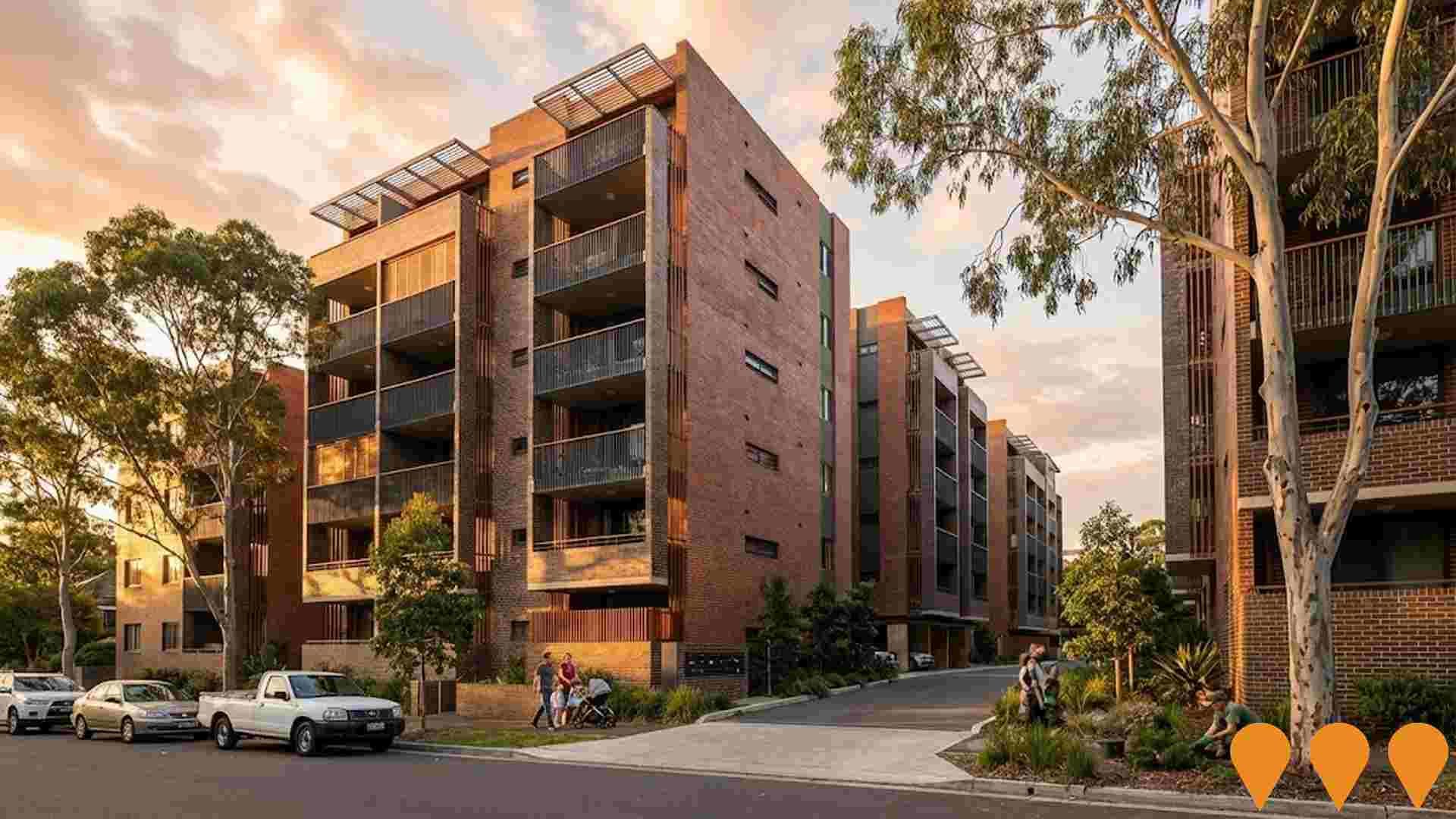Chart Color Schemes
est. as @ -- *
ABS ERP | -- people | --
2021 Census | -- people
Sales Activity
Curious about local property values? Filter the chart to assess the volume and appreciation (including resales) trends and regional comparisons, or scroll to the map below view this information at an individual property level.
Find a Recent Sale
Sales Detail
Population
Glebe - Forest Lodge has seen population growth performance typically on par with national averages when looking at short and medium term trends
Glebe - Forest Lodge's population is approximately 21,843 as of November 2025. This figure represents an increase of 1,581 people from the 2021 Census total of 20,262, indicating a growth rate of 7.8%. The estimated resident population in June 2024 was 21,794, with an additional 120 validated new addresses since the Census date contributing to this increase. This results in a population density of 9,497 persons per square kilometer, placing Glebe - Forest Lodge among the top 10% of locations assessed nationwide by AreaSearch. The area's growth rate exceeded that of the state (6.7%), making it a regional growth leader since the 2021 Census. Overseas migration accounted for approximately 87.4% of overall population gains during recent periods, driving this growth.
AreaSearch adopts ABS/Geoscience Australia projections for each SA2 area, released in 2024 with 2022 as the base year. For areas not covered by this data, AreaSearch uses NSW State Government's SA2 level projections, released in 2022 with 2021 as the base year. Growth rates by age group from these aggregations are applied to all areas for years 2032 to 2041. Looking ahead, population growth is projected to slow to a lower quartile rate nationally. By 2041, Glebe - Forest Lodge's population is expected to grow by approximately 620 persons based on the latest numbers, representing an overall gain of 2.6% over the 17-year period.
Frequently Asked Questions - Population
Development
AreaSearch assessment of residential development drivers sees a low level of activity in Glebe - Forest Lodge, placing the area among the bottom 25% of areas assessed nationally
Glebe - Forest Lodge has seen approximately 28 new homes approved annually. Over the past five financial years, from FY-21 to FY-25, around 143 homes were approved, with an additional 45 approved so far in FY-26. On average, about 1.5 new residents arrived per year for each new home built over these five years. However, recent data shows this ratio has intensified to 96.2 people per dwelling over the past two financial years, suggesting growing popularity and potential undersupply.
New homes are being constructed at an average expected cost of $498,000, indicating a focus on the premium market with high-end developments. This year alone, $543.9 million in commercial approvals have been registered, reflecting robust local business investment. Compared to Greater Sydney, Glebe - Forest Lodge has significantly less development activity, 76.0% below the regional average per person. This scarcity of new dwellings typically strengthens demand and prices for existing properties. The market reflects maturity, with 14.0% detached houses and 86.0% attached dwellings among approved buildings, providing accessible entry options appealing to downsizers, investors, and entry-level buyers. With around 3708 people per dwelling approval, Glebe - Forest Lodge indicates a highly mature market.
Population forecasts project an increase of 571 residents by 2041. Given current construction levels, housing supply should adequately meet demand, creating favourable conditions for buyers while potentially enabling growth that exceeds current forecasts.
Frequently Asked Questions - Development
Infrastructure
Glebe - Forest Lodge has very high levels of nearby infrastructure activity, ranking in the top 10% nationally
Changes to local infrastructure significantly impact an area's performance. AreaSearch identified 40 projects likely affecting the region. Notable initiatives include New Sydney Fish Market, Cowper Street Social Housing Development, Wentworth Park Rd in Glebe, and Elger Street Social Housing. The following list details those projects expected to have the most relevance.
Professional plan users can use the search below to filter and access additional projects.
INFRASTRUCTURE SEARCH
 Denotes AI-based impression for illustrative purposes only, not to be taken as definitive under any circumstances. Please follow links and conduct other investigations from the project's source for actual imagery. Developers and project owners wishing us to use original imagery please Contact Us and we will do so.
Denotes AI-based impression for illustrative purposes only, not to be taken as definitive under any circumstances. Please follow links and conduct other investigations from the project's source for actual imagery. Developers and project owners wishing us to use original imagery please Contact Us and we will do so.
Frequently Asked Questions - Infrastructure
New Sydney Fish Market
The NSW Government is delivering a purpose-built new Sydney Fish Market at Blackwattle Bay designed by 3XN with BVN and Aspect Studios. The c. 26,000 sqm facility will house retail, restaurants and bars, fishmongers and wholesale auction facilities, new wharf and boating infrastructure, and a continuous public foreshore promenade. Construction is nearing completion with government indicating building completion and handover to the operator in late 2025, with public opening scheduled for 19 January 2026. The project is expected to attract over 6 million visitors annually.
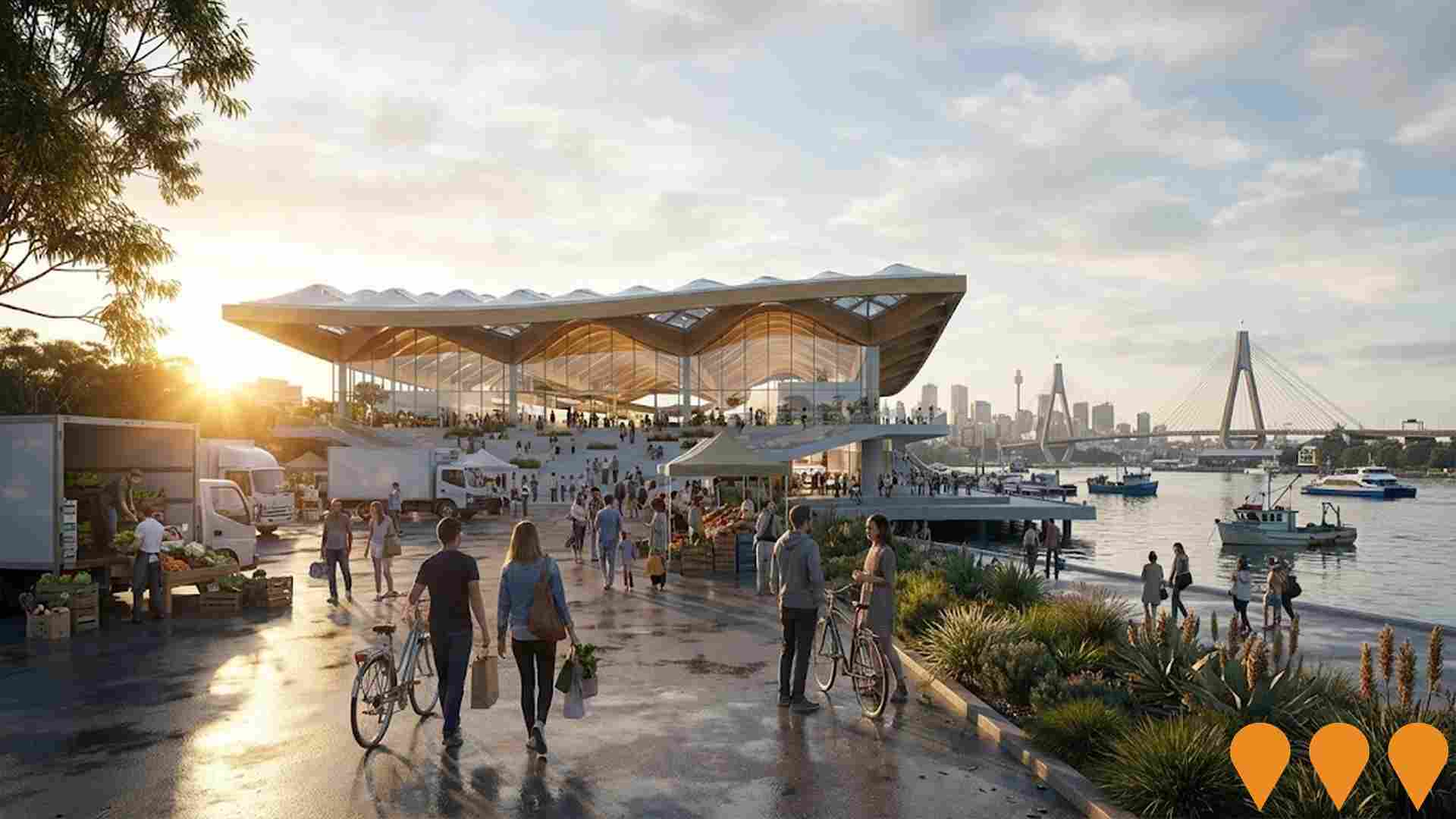
Royal Prince Alfred Hospital Redevelopment
The NSW Government has committed $940 million to the redevelopment of Royal Prince Alfred (RPA) Hospital. This is the most significant redevelopment in the hospital's 140-year history. The project is in the construction phase and includes a new 15-storey East Tower, vertical and horizontal expansions to existing structures, and major refurbishments. Key features are an expanded Emergency Department, enhanced Intensive Care Unit, new operating theatres, and expanded women's, babies', and paediatric units. The main works contract was awarded to CPB Contractors in March 2024.

Sydney Metro West - The Bays Station
A major underground station part of the 24km Sydney Metro West line, located between Glebe Island and White Bay Power Station. The project involves the transformation of the Bays West precinct into a mixed-use innovation hub, featuring approximately 250 new homes, commercial and retail spaces, and significant public foreshore access. Tunnelling and station box excavation are well underway, with the line targeting a 2032 opening.
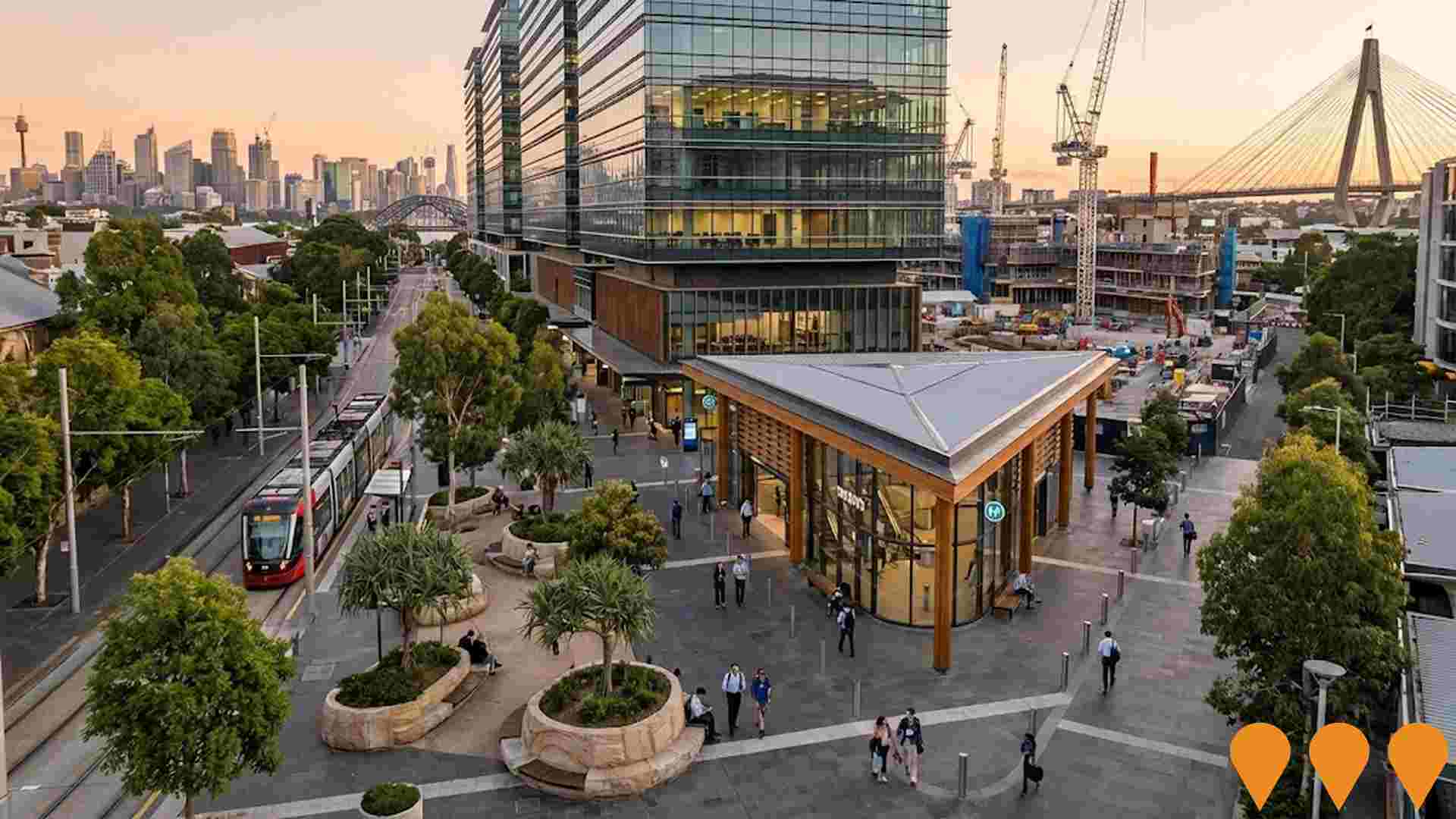
Powerhouse Ultimo Renewal
Major renewal and expansion of the Powerhouse Museum (Museum of Applied Arts and Sciences) in Ultimo. The project delivers new exhibition and education spaces, a 2,000 sqm public plaza on The Goods Line, rooftop venues, improved pedestrian links, heritage restoration of the Ultimo Powerhouse building, and adaptive reuse of the former Harwood building.
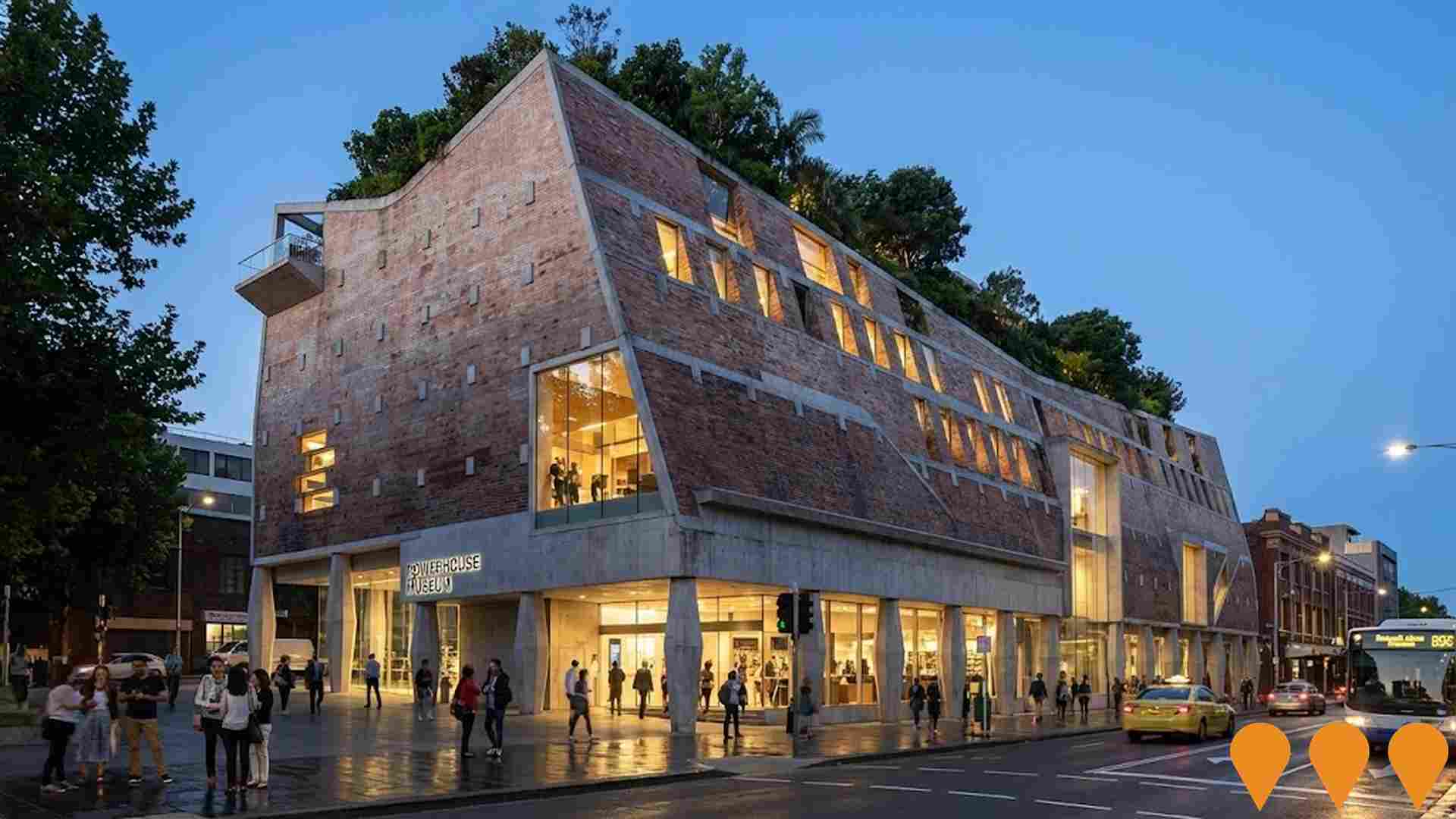
Blackwattle Bay Precinct Development
Urban renewal of over 10 hectares of former industrial waterfront land into a mixed-use precinct. Delivers approximately 1,500 new homes (including 7.5% affordable housing following 2025 SEPP amendment), ~100,000 mý commercial/retail floorspace creating around 5,600 jobs, a 30 m wide waterfront promenade completing the 15 km harbourside walk, 1.1 ha Bank Street park, over 34,000 mý total new public open space, and climate-responsive sustainable design integrating cultural and heritage elements. Led by Infrastructure NSW as part of The Bays renewal.
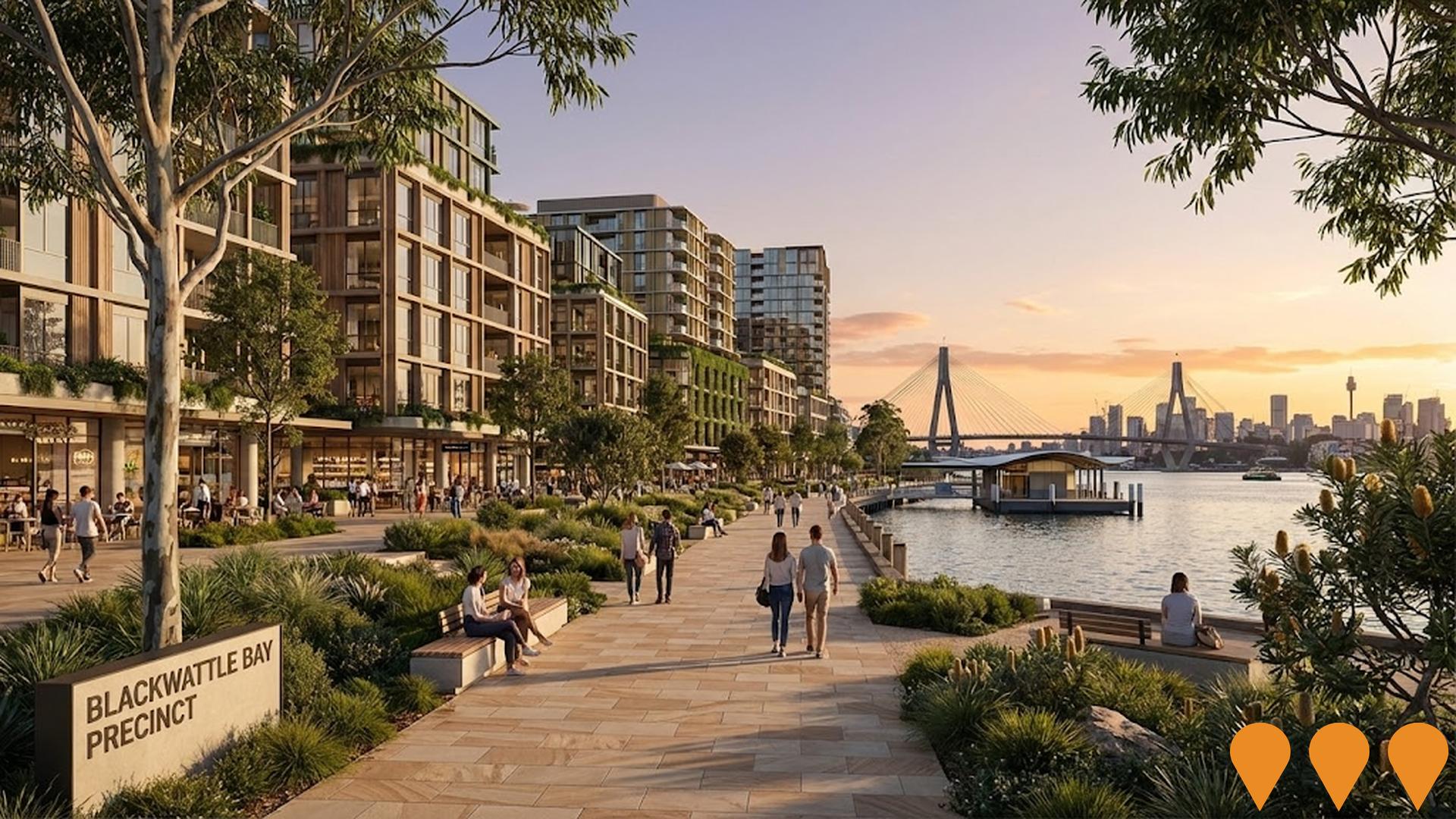
Camperdown Modern Private Hospital
Camperdown Modern is a $135 million purpose-built healthcare facility delivering 10,300 square metres of state-of-the-art health facilities. Located in the Camperdown Health Education Research Precinct (CHERP), it will feature large flexible floor plates accommodating day surgeries, pathology, radiology, mental rehabilitation, consulting suites and potentially 120-130 patient beds.

Bank Street Park (Blackwattle Bay)
A new 1.1-hectare waterfront public park surrounding the southern pylons of the Anzac Bridge. The design includes a waterside promenade, playground, multipurpose court, outdoor fitness station, community building with amenities and cafe kiosk, dragon boat storage and kayak launch, cycle paths and enhanced water access. The State Significant Development Application was approved in July 2024, with a design modification approved in July 2025 to improve access, circulation and building layouts. Procurement for a construction contractor is underway with a shortlisted tender panel.
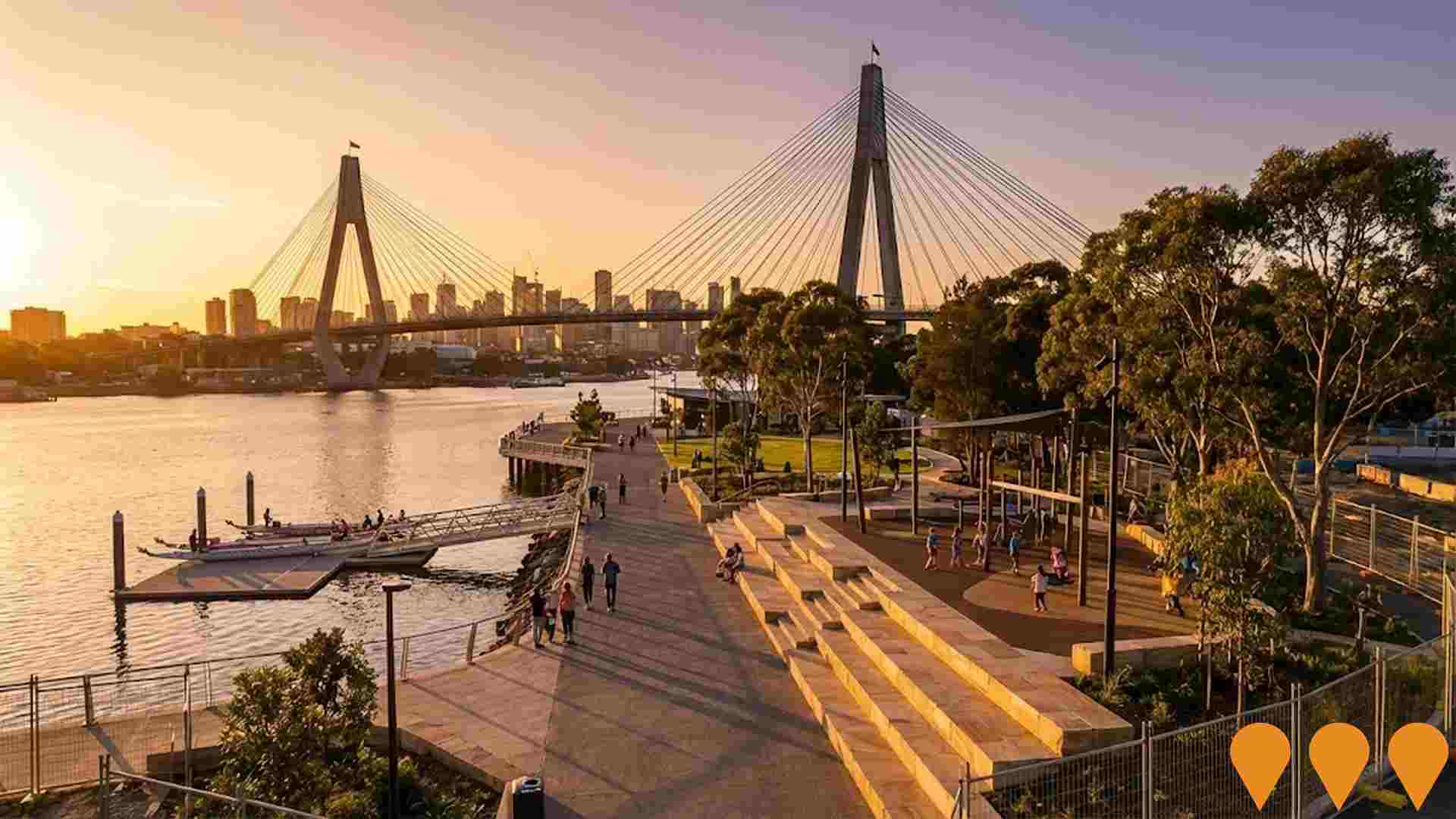
University of Sydney Campus Transformation
Ongoing transformation of the University of Sydney's Camperdown/Darlington campus including the recent opening of the Chau Chak Wing Museum and ongoing developments in engineering, science, and student accommodation facilities. The project enhances research capabilities and student experience.

Employment
Employment performance in Glebe - Forest Lodge has been below expectations when compared to most other areas nationally
Glebe - Forest Lodge has a highly educated workforce with significant representation in the technology sector. Its unemployment rate is 7.2%, slightly higher than Greater Sydney's 4.2%.
Employment stability in the area has been relatively consistent over the past year. As of June 2025, 13,088 residents are employed, with an unemployment rate of 10.2% compared to Greater Sydney's 4.2%. The workforce participation rate is 66.0%, higher than Greater Sydney's 60.0%. Employment is concentrated in professional & technical services (1.7 times the regional average), health care & social assistance, and education & training.
Construction employment is limited at 3.7% compared to the regional average of 8.6%. Many residents commute outside the area for work based on Census data analysis. Between June 2024 and June 2025, employment increased by 0.5%, while labour force grew by 0.7%, leading to a rise in unemployment rate by 0.2 percentage points. In comparison, Greater Sydney saw employment growth of 2.6% and unemployment rose by 0.3 percentage points. Jobs and Skills Australia's national employment forecasts from May 2025 project overall growth of 6.6% over five years and 13.7% over ten years. Applying these projections to Glebe - Forest Lodge's employment mix suggests local growth could be approximately 7.5% over five years and 14.9% over ten years, though these are simple extrapolations for illustrative purposes only.
Frequently Asked Questions - Employment
Income
Income metrics indicate excellent economic conditions, with the area achieving higher performance than 75% of national locations assessed by AreaSearch
AreaSearch's latest postcode level ATO data for financial year 2022 shows Glebe - Forest Lodge had a median income of $64,577 and an average of $98,071. Nationally, this is exceptionally high compared to Greater Sydney's median of $56,994 and average of $80,856. By September 2025, estimates suggest the median income will be approximately $72,720 and the average will be around $110,438, based on a 12.61% growth in Wage Price Index since financial year 2022. Census data indicates individual earnings reach the 92nd percentile nationally at $1,230 weekly. Income distribution shows 26.3% of the population (5,744 individuals) fall within the $1,500 - 2,999 income range, mirroring the surrounding region's 30.9%. Notably, 35.2% earn above $3,000 weekly, reflecting areas of prosperity driving local economic activity. High housing costs consume 21.5% of income, yet strong earnings place disposable income at the 62nd percentile nationally. The area's SEIFA income ranking places it in the 9th decile.
Frequently Asked Questions - Income
Housing
Glebe - Forest Lodge features a more urban dwelling mix with significant apartment living, with above-average rates of outright home ownership
In Glebe - Forest Lodge, as recorded in the latest Census, 3.6% of dwellings were houses while 96.4% were other types such as semi-detached homes and apartments, compared to Sydney metropolitan areas' 2.3% houses and 97.7% other dwellings. Home ownership in Glebe - Forest Lodge stood at 17.7%, with mortgaged dwellings at 18.4% and rented ones at 63.8%. The median monthly mortgage repayment was $2,949, higher than Sydney metro's average of $2,705. Median weekly rent in Glebe - Forest Lodge was $505, compared to Sydney metro's $550. Nationally, mortgage repayments were significantly higher at $1,863 and rents substantially above the national figure of $375.
Frequently Asked Questions - Housing
Household Composition
Glebe - Forest Lodge features high concentrations of lone person households and group households, with a fairly typical median household size
Family households constitute 49.4% of all households, including 13.7% couples with children, 27.6% couples without children, and 7.0% single parent families. Non-family households account for the remaining 50.6%, with lone person households at 42.1% and group households comprising 8.5%. The median household size is 1.9 people, which aligns with the Greater Sydney average.
Frequently Asked Questions - Households
Local Schools & Education
Glebe - Forest Lodge shows strong educational performance, ranking in the upper quartile nationally when assessed across multiple qualification and achievement indicators
Educational attainment in Glebe - Forest Lodge is notably higher than broader benchmarks. As of a specific date or period not detailed here, 61.2% of residents aged 15+ held university qualifications, compared to 30.4% nationally and 32.2% in NSW. University qualifications include bachelor degrees at 35.9%, postgraduate qualifications at 21.4%, and graduate diplomas at 3.9%. Vocational pathways account for 17.5%, with advanced diplomas at 8.9% and certificates at 8.6%.
Educational participation is high, with 29.5% of residents currently enrolled in formal education, including 14.8% in tertiary education, 5.0% in primary education, and 3.5% pursuing secondary education. There are seven schools operating within Glebe - Forest Lodge, educating approximately 2,954 students as of a specific date or period not detailed here. The area demonstrates above-average socio-educational conditions with an ICSEA score of 1092. Educational provision is split between three primary and four secondary institutions. As of a specific date or period not detailed here, the area functions as an education hub with 13.5 school places per 100 residents, significantly above the regional average of 7.7, attracting students from surrounding communities.
Frequently Asked Questions - Education
Schools Detail
Nearby Services & Amenities
Transport
Transport servicing is high compared to other areas nationally based on assessment of service frequency, route connectivity and accessibility
Glebe - Forest Lodge has 57 active public transport stops. These include ferry, lightrail, and bus services. There are 37 different routes operating in total, which combined offer 9,995 weekly passenger trips.
The average distance from residences to the nearest stop is 132 meters, indicating excellent accessibility. Daily service frequency averages 1,427 trips across all routes, translating to about 175 weekly trips per individual stop.
Frequently Asked Questions - Transport
Transport Stops Detail
Health
Glebe - Forest Lodge's residents are extremely healthy with both young and old age cohorts seeing low prevalence of common health conditions
Analysis of health metrics shows strong performance throughout Glebe - Forest Lodge. Both young and old age cohorts saw low prevalence of common health conditions.
The rate of private health cover was exceptionally high at approximately 70% of the total population (15,246 people), compared to the national average of 55.3%. The most common medical conditions in the area were mental health issues and asthma, impacting 10.8 and 7.6% of residents respectively. Seventy-one point eight percent declared themselves completely clear of medical ailments, compared to 77.4% across Greater Sydney. The area has 14.1% of residents aged 65 and over (3,068 people), which is higher than the 9.7% in Greater Sydney. Health outcomes among seniors are particularly strong, broadly in line with the general population's health profile.
Frequently Asked Questions - Health
Cultural Diversity
Glebe - Forest Lodge is among the most culturally diverse areas in the country based on AreaSearch assessment of a range of language and cultural background related metrics
Glebe-Forest Lodge has a high level of cultural diversity, with 27.2% of its population speaking a language other than English at home and 40.8% born overseas. Christianity is the predominant religion in Glebe-Forest Lodge, making up 30.8% of people. However, Judaism is overrepresented compared to Greater Sydney, comprising 0.7% versus 1.1%.
The top three ancestry groups are English (22.2%), Australian (16.2%), and Other (12.6%). Notably, French (1.0%) and Russian (0.7%) are overrepresented compared to regional percentages of 1.1% and 0.8%, respectively.
Frequently Asked Questions - Diversity
Age
Glebe - Forest Lodge's population is slightly younger than the national pattern
Glebe-Forest Lodge's median age is 36 years, nearly matching Greater Sydney's average of 37 years, which is slightly below the Australian median of 38 years. Compared to Greater Sydney, Glebe-Forest Lodge has a higher proportion of residents aged 25-34 (24.1%) but fewer residents aged 5-14 (5.5%). This concentration of 25-34 year-olds is significantly higher than the national average of 14.5%. Between the 2021 Census and the present, the proportion of residents aged 15 to 24 has grown from 12.3% to 15.1%, while the proportion of those aged 75 to 84 has increased from 3.7% to 4.8%. Conversely, the proportion of those aged 55 to 64 has declined from 10.8% to 9.7%. By 2041, demographic modeling suggests significant changes in Glebe-Forest Lodge's age profile. The 75 to 84 cohort is projected to grow by 56%, adding 589 residents to reach a total of 1,634. Residents aged 65 and above are expected to drive 81% of population growth, highlighting demographic aging trends. However, the 15 to 24 and 0 to 4 age cohorts are projected to experience population declines.



